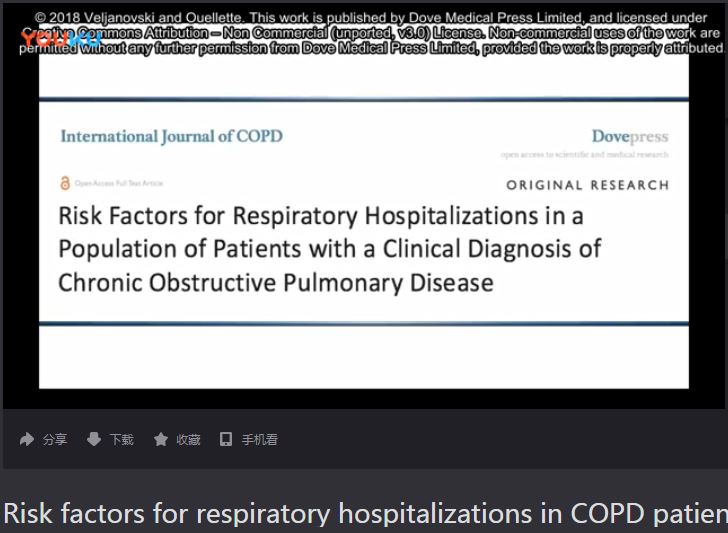9 1 2 3 6
论文已发表
注册即可获取德孚的最新动态
IF 收录期刊
- 2.6 Breast Cancer (Dove Med Press)
- 3.9 Clin Epidemiol
- 3.3 Cancer Manag Res
- 3.9 Infect Drug Resist
- 3.6 Clin Interv Aging
- 4.8 Drug Des Dev Ther
- 2.8 Int J Chronic Obstr
- 8.0 Int J Nanomed
- 2.3 Int J Women's Health
- 3.2 Neuropsych Dis Treat
- 4.0 OncoTargets Ther
- 2.2 Patient Prefer Adher
- 2.8 Ther Clin Risk Manag
- 2.7 J Pain Res
- 3.3 Diabet Metab Synd Ob
- 4.3 Psychol Res Behav Ma
- 3.4 Nat Sci Sleep
- 1.9 Pharmgenomics Pers Med
- 3.5 Risk Manag Healthc Policy
- 4.5 J Inflamm Res
- 2.3 Int J Gen Med
- 4.1 J Hepatocell Carcinoma
- 3.2 J Asthma Allergy
- 2.3 Clin Cosmet Investig Dermatol
- 3.3 J Multidiscip Healthc

Risk factors for respiratory hospitalizations in a population of patients with a clinical diagnosis of COPD
Authors Veljanovski J, Ouellette DR
Received 16 November 2017
Accepted for publication 8 February 2018
Published 28 March 2018 Volume 2018:13 Pages 1061—1069
DOI https://doi.org/10.2147/COPD.S157230
Checked for plagiarism Yes
Review by Single-blind
Peer reviewers approved by Dr Charles Downs
Peer reviewer comments 2
Editor who approved publication: Dr Richard Russell
Purpose: The purpose of this study was to examine differences between
patients clinically diagnosed with COPD with and without obstruction by spirometry
and to identify risk factors for respiratory hospitalizations.
Materials and methods: This is a retrospective analysis of all patients
diagnosed with COPD at a large academic Internal Medicine Clinic in 2014, who
had spirometry performed during the period 2013–2014. Two groups existed: one
with obstruction termed classical COPD and another without obstruction.
Demographics, comorbidities, prescribed medications, spirometry, respiratory
hospitalization, and eosinophilia among other variables were compared between
patients with and without obstruction. Risk factors for two or more respiratory
hospitalizations during the period 2014–2015 were sought for both populations
by both univariate and multivariate analyses. Subsequently, we studied the population
without obstruction for risk factors for one or more respiratory
hospitalizations first by univariate analysis and then by multivariate
analysis.
Results: Among 657 patients, 210 met inclusion criteria,
with 157 having obstruction on spirometry and 53 without obstruction. There was
no difference between those with and without obstruction on the rate of
respiratory hospitalization when using two or more respiratory hospitalizations
(p =0.397) or one or more
respiratory hospitalizations (p =0.467). Nontreatment
risk factors associated with two or more respiratory hospitalizations by
multivariate analysis included a maximum eosinophil count above the threshold
of 0.5 K/µL (maximum eosinophil number threshold [MENT]; p =0.001, OR =3.792, 95% CI
=1.676–8.582) and % predicted forced expiratory volume in the first second (p =0.031, OR =0.978, 95% CI
=0.959–0.998). In patients without obstruction, MENT above the threshold of 0.5
K/µL (p =0.032, OR =5.087, 95% CI
=1.147–22.557) was the only risk factor associated with one or more respiratory
hospitalizations.
Conclusion: In a clinically diagnosed COPD population who
had spirometry performed, the presence of airflow obstruction was not a risk
factor for respiratory hospitalizations. The most significantly associated nontreatment
factor associated with respiratory hospitalization, both in the study
population as a whole and in the cohort without obstruction, was MENT above the
threshold of 0.5 K/µL.
Keywords: chronic
obstructive pulmonary disease, airflow obstruction, spirometry, eosinophilia
摘要视频链接:Risk factors for respiratory
hospitalizations in COPD patients
